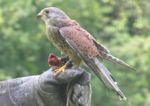Difference between revisions of "Avian Oral Cavity - Anatomy & Physiology"
Jump to navigation
Jump to search
m (Text replace - "[[Enamel Organ|" to "[[Tooth - Anatomy & Physiology|") |
|||
| (18 intermediate revisions by 3 users not shown) | |||
| Line 1: | Line 1: | ||
| − | {{ | + | {{OpenPagesTop}} |
| − | |||
| − | |||
| − | |||
| − | |||
| − | |||
| − | |||
| − | }} | ||
[[Image:Kestrel beak.jpg|thumb|right|150px|Beak of a kestrel - Copyright nabrown RVC]] | [[Image:Kestrel beak.jpg|thumb|right|150px|Beak of a kestrel - Copyright nabrown RVC]] | ||
==Introduction== | ==Introduction== | ||
| − | In avian species, the [[Lips | + | In avian species, the [[Lips|lips]] and [[Cheeks|cheeks]] are replaced by the [[Skin - Anatomy & Physiology#Cutaneous Appendages|beak]]. |
| − | The [[ | + | The [[Integument of Exotic Species - Anatomy & Physiology#The Beak|beak]] is an area of dense, horny skin overlying the [[Skull and Facial Muscles - Anatomy & Physiology#Incisive Bone (os incisivium)|incisive bones]] of the [[Skull and Facial Muscles - Anatomy & Physiology#Mandible (mandibula)|mandible]]. |
| − | No modern birds possess [[ | + | No modern birds possess [[:Category:Teeth - Anatomy & Physiology|teeth]], however rudimentary [[Tooth - Anatomy & Physiology|enamel organs]] have been discovered in the embryos of some birds. |
| − | The size and structure of the avian [[ | + | The size and structure of the avian [[Avian Tongue - Anatomy & Physiology|tongue]] varies between species; it is related to the functional requirements of each species. |
| − | The | + | The [[Avian Hard Palate|avian hard palate]] contains a slit-like opening called the choanal opening which communicates with the nasal pharynx. |
[[Image:Avian Tongue and Oral Cavity.jpg|thumb|right|150px|Avian Tongue - Copyright RVC 2008]] | [[Image:Avian Tongue and Oral Cavity.jpg|thumb|right|150px|Avian Tongue - Copyright RVC 2008]] | ||
| − | + | {{Template:Learning | |
| − | + | |flashcards = [[The Avian Alimentary Tract - Anatomy & Physiology - Flashcards|Avian Alimentary Tract]] | |
| − | [[The Avian Alimentary Tract - Anatomy & Physiology - Flashcards|Avian Alimentary Tract | + | |OVAM = [http://www.onlineveterinaryanatomy.net/content/interactive-avian-anatomy-bucopharyngeal-cavity-4 Avian Interactive Anatomy - Bucopharyngeal Cavity 1]<br>[http://www.onlineveterinaryanatomy.net/content/interactive-avian-anatomy-bucopharyngeal-cavity-3 Avian Interactive Anatomy - Bucopharyngeal Cavity 2]<br>[http://www.onlineveterinaryanatomy.net/content/interactive-avian-anatomy-bucopharyngeal-cavity-2 Avian Interactive Anatomy - Bucopharyngeal Cavity 3]<br>[http://www.onlineveterinaryanatomy.net/content/interactive-avian-anatomy-bucopharyngeal-cavity-1 Avian Interactive Anatomy - Bucopharyngeal Cavity 4]<br>[http://www.onlineveterinaryanatomy.net/content/interactive-avian-anatomy-bucopharyngeal-cavity-5 Avian Interactive Anatomy - Bucopharyngeal Cavity 5]<br>[http://www.onlineveterinaryanatomy.net/content/interactive-avian-anatomy-bucopharyngeal-cavity-0 Avian Interactive Anatomy - Bucopharyngeal Cavity 6] |
| − | + | }} | |
| − | [[Category:Alimentary System]] | + | {{OpenPages}} |
| + | [[Category:Avian Alimentary System - Anatomy & Physiology]] | ||
| + | [[Category:A&P Done]] | ||
Latest revision as of 13:17, 2 November 2014
Introduction
In avian species, the lips and cheeks are replaced by the beak.
The beak is an area of dense, horny skin overlying the incisive bones of the mandible.
No modern birds possess teeth, however rudimentary enamel organs have been discovered in the embryos of some birds.
The size and structure of the avian tongue varies between species; it is related to the functional requirements of each species.
The avian hard palate contains a slit-like opening called the choanal opening which communicates with the nasal pharynx.
| Avian Oral Cavity - Anatomy & Physiology Learning Resources | |
|---|---|
 Test your knowledge using flashcard type questions |
Avian Alimentary Tract |
Anatomy Museum Resources |
Avian Interactive Anatomy - Bucopharyngeal Cavity 1 Avian Interactive Anatomy - Bucopharyngeal Cavity 2 Avian Interactive Anatomy - Bucopharyngeal Cavity 3 Avian Interactive Anatomy - Bucopharyngeal Cavity 4 Avian Interactive Anatomy - Bucopharyngeal Cavity 5 Avian Interactive Anatomy - Bucopharyngeal Cavity 6 |
Error in widget FBRecommend: unable to write file /var/www/wikivet.net/extensions/Widgets/compiled_templates/wrt663b1297ad9110_89459934 Error in widget google+: unable to write file /var/www/wikivet.net/extensions/Widgets/compiled_templates/wrt663b1297b12755_35976448 Error in widget TwitterTweet: unable to write file /var/www/wikivet.net/extensions/Widgets/compiled_templates/wrt663b1297b452c0_26948933
|
| WikiVet® Introduction - Help WikiVet - Report a Problem |

